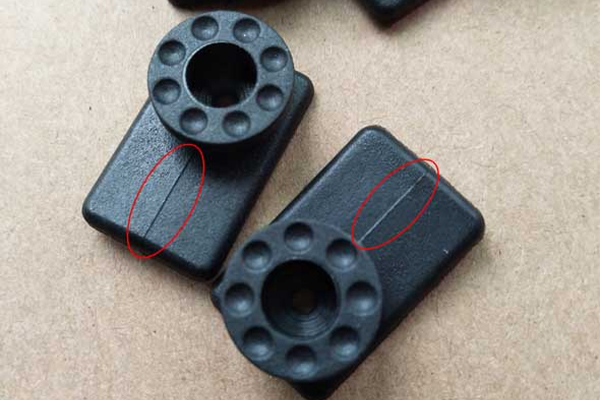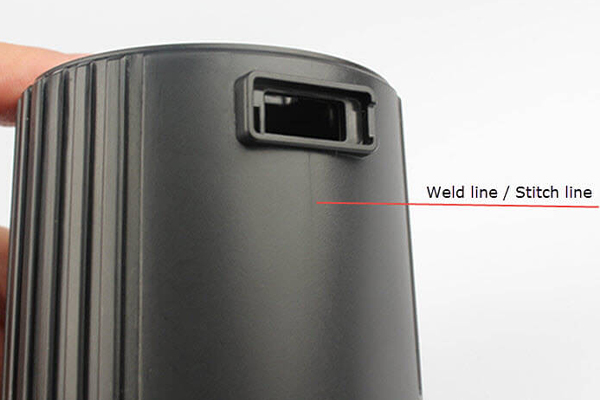Injection Molding Defects: Weld Lines

Why Do Weld Lines Appear in Injection Molding?
Injection molding weld lines occur due to the specific dynamics of the injection molding process, where molten plastic material is injected into a mold to form a part. These lines develop when two separate flows of molten plastic meet and join together during this process. Here’s a breakdown of why injection molding weld lines occur:
-
- Flow Front Division:
In the injection molding process, the molten plastic material flows into the mold cavity through channels and gates. When the part design includes features like holes, notches, or other complexities, these features can act as barriers or obstacles to the flow of molten plastic. - Flow Convergence:
As the material flows through the mold, it encounters these features and divides into separate “flow fronts.” Each flow front goes around these features and then converges or reunites on the other side. - Meeting of Flow Fronts:
At the point where the separated flow fronts come together or meet, they “weld” or join together. However, this joining is not always seamless. The material from the separate flow fronts may not fully intermix, leading to a slight line or notch on the part’s surface, which is the weld line.
- Flow Front Division:
Several factors contribute to the formation of weld marks at these convergence points, including temperature gradients, cooling rates, and the orientation of polymer molecules. These factors can result in insufficient fusion of the plastic material at the weld line location.
While weld lines can be visually noticeable, they are generally not a result of material or process deficiencies and do not weaken the part unless there are significant processing errors. Proper design, material selection, and process optimization can help minimize the appearance and impact of injection molding weld lines.

Are Weld Lines Serious Problem?
Weld lines, although they can raise aesthetic concerns, typically do not signify shortcomings in the quality of the raw material, the mold, or the manufacturing process. These lines generally do not compromise the structural integrity of the part unless there are errors in how the part is processed.
The primary considerations regarding weld marks revolve around appearance and functionality. From an aesthetic perspective, visible weld marks may be undesirable in applications where product aesthetics are critical, such as consumer electronics or high-end consumer goods. In such cases, minimizing or eliminating weld lines becomes a priority to maintain a polished and flawless appearance.
From a functional standpoint, as long as the injection molding process is executed correctly, weld marks should not pose a risk to the part’s strength or performance. However, it’s crucial to ensure that the injection molding process is optimized to prevent issues like poor fusion, which could potentially weaken the part if not managed properly.
In essence, the significance of weld lines hinges on the specific application and the quality standards set for the finished product. While they might not inherently weaken the part, addressing them appropriately is essential to meet visual and functional expectations.
Strategies for Solving Weld Lines Issues
There are several techniques available for mitigating weld lines or relocating them to more favorable positions for aesthetic and structural purposes. However, it’s important to note that attempting to resolve weld line problems may introduce other, potentially more significant challenges. Therefore, it is advisable to consult your plastic injection molding manufacturer before considering any of the following modifications to address weld marks. Addressing weld line problems in plastic injection molding requires a systematic approach. Here are strategies to effectively solve weld line issues:
-
- Design for Manufacturability (DFM):
Utilize computer simulations and a DFM approach during the design phase to predict and mitigate weld line issues. By communicating effectively with manufacturers, potential issues can be identified and resolved early. - Temperature Control:
Optimize mold and material temperatures to encourage better fusion between flow fronts. Adjusting these temperatures can help minimize the visibility of weld lines. - Gate Location Optimization:
Carefully select and position gates to control the flow of molten plastic. Strategic gate placement can reduce the prominence or visibility of weld marks on the final product. - Design Modification for Uniform Flow:
Adjust the part’s design to promote a more uniform flow of material during injection. This can eliminate the need for multiple flow fronts to converge, reducing weld line issues. - Runner System Improvement:
Optimize the dimensions of the runner system to maintain a higher temperature at the leading edge of each flow front. This can help prevent the formation of weld marks. - Injection Speed Adjustment:
Increase the injection speed to expedite material filling in the mold. Faster injection can reduce the chances of premature cooling and potential weld line formation. It may also change the location where flow fronts meet. - Material Selection and Modification:
Choose a plastic material with lower viscosity or a lower melting point to enhance material flow properties, minimizing or relocating weld lines. - Post-Injection Operations:
Consider secondary operations, such as post-molding machining or finishing, to remove or mask weld lines if they cannot be entirely eliminated during the injection molding process.
For example: Painting and Coating. Applying paint or specialized coatings to the part’s surface can effectively mask or conceal weld lines. This is common in applications where appearance is critical. - Heat Staking:
Heat staking involves localized heating of the weld line area to reflow the material, improving its bond and reducing the visibility of the weld line. - Ultrasonic Welding:
Ultrasonic welding can be used as a post-finishing technique to re-melt and fuse the plastic at the weld line, creating a stronger and more seamless joint. - Vibration Welding:
For thermoplastic parts, vibration welding can be employed as a post-finishing method to re-melt and fuse the weld line, producing a more cohesive bond. - Insert Molding:
Incorporating inserts or additional components during the injection molding process can help strengthen and reinforce areas prone to weld lines. - Secondary Machining:
In some cases, precision machining techniques can be used to remove or minimize weld lines, especially if they are causing dimensional or structural issues. - Quality Control and Inspection:
Implement rigorous quality control procedures and inspections to detect and address weld line defects as soon as they occur. Timely identification allows for corrective action during production. - Consultation with Experts:
Working with Sungplastic, our experienced team of engineers can effectively assess and troubleshoot weld issues. Our expertise can provide valuable insights and solutions.
- Design for Manufacturability (DFM):
In practice, these strategies combined with careful process optimization and manufacturability design practices can minimize the visibility and impact of welds in injection molded parts.
Sungplastic is an experienced injection molding manufacturer and we perform a thorough design for manufacturability process to help you identify existing and potential issues and correct them during the mold design phase. By selecting materials with higher melting and fluidity, accurately controlling mold temperature and heating temperature of plastic materials, and implementing strict quality control and inspection procedures, we minimize the impact of weld lines on products and provide higher quality products. We sincerely hope that the finished product will meet your expectations for the intended product.
Get a free quote and design analysis today.
We’ll reply to you within 6 working hours.
We respect your privacy.
+86 139 2927 4777 (WhatsApp, Wechat)
